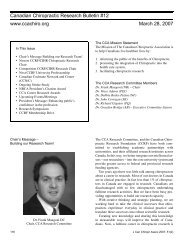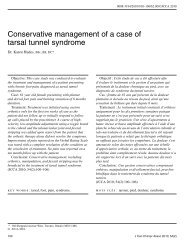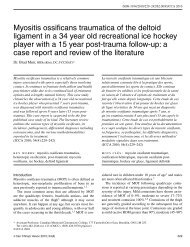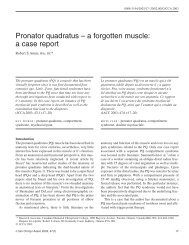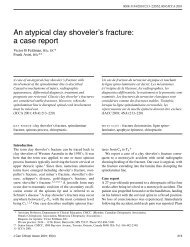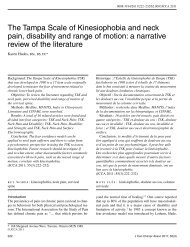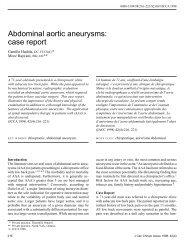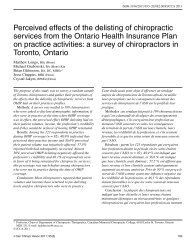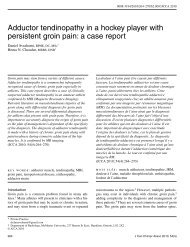The use of botulinum neurotoxin type A (Botox) - Journal of the ...
The use of botulinum neurotoxin type A (Botox) - Journal of the ...
The use of botulinum neurotoxin type A (Botox) - Journal of the ...
Create successful ePaper yourself
Turn your PDF publications into a flip-book with our unique Google optimized e-Paper software.
Botulinum <strong>neurotoxin</strong>positive results were found when <strong>the</strong> mean <strong>Botox</strong>-A dosewas 63.2 units, for a mean total treatment time <strong>of</strong> 8.6months, during which patients received an average <strong>of</strong> 3.4treatments. 12In 2005, <strong>the</strong> Cochrane Collaboration released a reviewon <strong>the</strong> effects <strong>of</strong> <strong>Botox</strong>-A injections on mechanical neckdisorders. It examined studies that were published up to2002 and concluded that <strong>the</strong>re was moderate evidence indicatingno benefit for <strong>Botox</strong>-A compared to saline intramuscularinjections. <strong>The</strong> five studies examined in thisreview, however, looked only at <strong>the</strong> results <strong>of</strong> one treatmentand <strong>the</strong> pain outcomes over four to eight weeks posttreatment 13 . Most recently in 2005, <strong>the</strong> two largest randomlydouble-blind, placebo-controlled trials were publishedby Ma<strong>the</strong>w et al and Silberstein et al. <strong>The</strong>se studies<strong>use</strong>d 702 and 571 patients respectively and conducted<strong>the</strong>ir studies over a period <strong>of</strong> 11 months. Both studies indicateda statistically significant decrease in <strong>the</strong> number<strong>of</strong> headache days per 30 day period when compared to aplacebo group. 10,11 Silberstein et al. looked at variousdosages and concluded that <strong>the</strong> most benefits comparedto placebo groups were found when <strong>the</strong> patient received150 Units <strong>of</strong> <strong>Botox</strong>-A per treatment. 10 This is significantlymore than <strong>the</strong> 20 Units <strong>use</strong>d in Schmitt’s 2001 study.Also <strong>of</strong> note is <strong>the</strong> fact that both <strong>of</strong> <strong>the</strong>se studies utilizedmultiple injection sites in multiple muscles, includingmuscles <strong>of</strong> both <strong>the</strong> head and neck. 10,11 All studies reportedadverse effects to be transient and mild to moderate inseverity. 9,10,11,12,14 Overall <strong>the</strong> current research suggeststhat <strong>Botox</strong>-A treatment may be an effective, well toleratedalternative treatment for <strong>the</strong> management <strong>of</strong> chronicheadache disorders.Central sensitization <strong>of</strong> central trigeminovascular neuronshas been determined to be an integral factor in <strong>the</strong> development,progression and maintenance <strong>of</strong> migraine<strong>type</strong>headaches. <strong>Botox</strong> has been shown to inhibit this. 5 Although<strong>the</strong> patient in this case report obtained reliefthrough conservative management <strong>of</strong> her headaches, itwas only up to two days. Alternatively, when she received<strong>the</strong> <strong>Botox</strong>-A treatments <strong>the</strong> relief lasted up to 4 months.As indicated by its various <strong>use</strong>s, and as illustrated in<strong>the</strong> case report, <strong>the</strong> most <strong>the</strong>rapeutic <strong>use</strong> <strong>of</strong> <strong>Botox</strong>-A is todecrease pain. This is accomplished through variousmethods. One method is by blocking <strong>the</strong> neuromusculartransmission. Blocking <strong>the</strong> release <strong>of</strong> acetylcholine stops<strong>the</strong> contraction <strong>of</strong> <strong>the</strong> muscle spindle, which in turn stops<strong>the</strong> pain-spasm-pain cycle and gives <strong>the</strong> patient relieffrom a painful posture. 15Ano<strong>the</strong>r method is based on <strong>the</strong> evidence that <strong>Botox</strong>-A’s effect on <strong>the</strong> SNARE proteins also decreases <strong>the</strong> release<strong>of</strong> pain mediators including substance P, calciumgene-related peptide (CGRP), and glutamate. 16 This maybe accomplished directly by blocking both substance Pfrom <strong>the</strong> trigeminal sensory afferent terminals, and <strong>the</strong>release <strong>of</strong> CGRP from autonomic vascular nerve terminals.It may also do this indirectly by inhibiting <strong>the</strong>release <strong>of</strong> glutamate, which stimulates <strong>the</strong> release <strong>of</strong>substance P and CGRP. 17,18 <strong>The</strong>se pain mediators are releasedfrom primary sensory afferent terminals in <strong>the</strong> injuredarea. <strong>The</strong>y produce neurogenic inflammation andsensitized pain receptors, providing a feedback circuit forcontinuing inflammation and muscle pain, hyperalgesiaand allodynia. 17 By blocking <strong>the</strong>ir release peripherally ananalgesic effect is created, however glutamate may alsobe blocked centrally.A third method relates to a recent study which foundthat <strong>Botox</strong>-A may ca<strong>use</strong> an analgesic effect without paralysiswhen it is conjugated with lectin and applied todorsal root ganglion cells. Here it selectively affects <strong>the</strong>nociceptive sensory afferents, C fibers, and can attenuatenociceptive transmission in vitro and in vivo for at least24 days. 17 <strong>Botox</strong>-A can thus prevent pain facilitation byalleviating <strong>the</strong> painful muscle contraction, blocking <strong>the</strong>pain neurotransmitters and interrupting <strong>the</strong> nociceptivesensory afferents.When administered for <strong>the</strong> treatment <strong>of</strong> headaches,<strong>Botox</strong> is released intramuscularly into various sites in <strong>the</strong>head and neck. <strong>The</strong> dosage is dependant on <strong>the</strong> size <strong>of</strong>muscle. Studies have shown effectiveness with as little as25 units. 19 According to one study, <strong>the</strong> clinical dose formigraine headaches is 25 to 100 units. 6 As <strong>the</strong>re is not yeta standardized methodology for <strong>the</strong> administration <strong>of</strong> <strong>Botox</strong>-A,<strong>the</strong> total dose administered should be individual,considering various factors such as <strong>the</strong> <strong>type</strong> <strong>of</strong> headache,severity <strong>of</strong> symptoms and body size. 12 <strong>The</strong> patient in <strong>the</strong>above case report experienced relief with doses <strong>of</strong> 120units.In disorders such as tension-<strong>type</strong> headaches, cervicogenicheadaches and migraines it is difficult to determinespecifically <strong>the</strong> involvement <strong>of</strong> hyperactive muscles. 6With respect to <strong>the</strong> occipital and cervical paraspinal regions(trapezius, splenius capitis, seminspinalis capitis),266 J Can Chiropr Assoc 2006; 50(4)
Botulinum <strong>neurotoxin</strong>Figure 1 Anterior injection sites in procerus andfrontalis muscles.Figure 3 Posterior view displaying splenius capitis andtrapezius muscles.Figure 2 Potential injection sites in temporalis muscle.Some patients received more or less depending upon painlocation.Figure 4 Injection sites in trapezius and splenius capitismuscles. <strong>The</strong> number <strong>of</strong> injection sites and doses varyfrom patient to patient depending upon size, painlocation, and palpable muscle spasm.268 J Can Chiropr Assoc 2006; 50(4)
M Oliver, J MacDonald, M Rajwanience any side effects, <strong>the</strong>y can occur. Adverse effects arelocalized to <strong>the</strong> area <strong>of</strong> injury and may be related to an excessivedose, or <strong>the</strong> inadvertent injection to adjacent areas.Adverse effects with respect to facial injections may includetransient ptosis, dry eyes, and bruising. Adverse effectswith respect to neck musculature may includedyspnea, xerostomia, na<strong>use</strong>a, fatigue, blurry vision andphotophobia. 21 Expected effects <strong>of</strong> <strong>Botox</strong>-A injections includelocal muscle weakness, flu-like symptoms, andrash. 23 According to a systematic review on <strong>the</strong> safety <strong>of</strong><strong>Botox</strong>-A, <strong>the</strong> overall rate <strong>of</strong> adverse events from treatmentwith <strong>Botox</strong>-A was 25%, <strong>of</strong> which <strong>the</strong>re were no severe orsystemic events. 21 Long term studies according to <strong>the</strong> systematicreview indicated that no severe effects occurred.Ano<strong>the</strong>r randomized double blind study indicated that 7out <strong>of</strong> 33 participants noted transient symptoms such asarm heaviness, and contralateral pain. One <strong>of</strong> <strong>the</strong>se participantsnoted a shift <strong>of</strong> neck pain to <strong>the</strong> midline which wassuccessfully managed with a chiropractic adjustment. 22According to an 11-month randomized double-blindplacebo-controlled study, <strong>Botox</strong> was shown to be an effective<strong>the</strong>rapy for <strong>the</strong>se <strong>type</strong>s <strong>of</strong> headaches. 6 Specifically,in <strong>the</strong> prevention and treatment <strong>of</strong> headaches, <strong>Botox</strong>was shown to be most effective in patients with recurringmigraines that interfere with <strong>the</strong>ir activities <strong>of</strong> normal lifedespite o<strong>the</strong>r treatments, in patients with frequent headaches,and with those who do not tolerate or complypoorly with acute treatment. 20In this case report, <strong>the</strong> patient had been experiencingchronic headaches and neck pain, and with increasedtime, began experiencing symptoms <strong>of</strong> anxiety, sleep disturbanceand short-term memory loss, all <strong>of</strong> which interferedwith her activities <strong>of</strong> normal life. After attemptingto relieve <strong>the</strong>se symptoms through conservative treatment,it was <strong>the</strong> <strong>Botox</strong>-A injections that finally allowedher to resume her daily activities in a pain-free manner.Given <strong>the</strong>se findings, it would be beneficial for chiropractorsto learn more about <strong>Botox</strong>-A, specifically, whenit should be <strong>of</strong>fered as an alternative treatment. A proposalfor <strong>the</strong> development <strong>of</strong> guidelines is suggested, suchthat chiropractors can in <strong>the</strong> future determine suitablecandidates for <strong>Botox</strong>-A treatment.Summary<strong>Botox</strong>-A is <strong>the</strong> sero<strong>type</strong> <strong>of</strong> a <strong>neurotoxin</strong> which, whencombined with non-toxic proteins can be utilized for<strong>the</strong>rapeutic purposes. It is injected into a target tissue andflaccid paralysis occurs, which decreases muscle hyperactivityand ultimately decreases pain within a short timeframe. At <strong>the</strong> present time, <strong>Botox</strong> injection for pain managementremains somewhat controversial, and more RCTstudies as well as studies <strong>of</strong> <strong>the</strong> long term outcomes andoutcome measures are necessary.A case <strong>of</strong> a 45-year-old woman who was treated with<strong>Botox</strong>-A for chronic neck pain and headaches is presented.She was initially treated with conservative care includingmanipulation, acupuncture and trigger point <strong>the</strong>rapy,however, this only provided short-term relief. Following<strong>Botox</strong>-A treatment she experienced pain relief immediatelywhich lasted up to 4 months. She has been receiving<strong>Botox</strong>-A injections approximately every 4 months for oneyear and has noticed an increase in energy and overallimprovements in her normal daily activities. This caseillustrates <strong>the</strong> importance <strong>of</strong> having alternatives to conservativetreatment for chiropractors. Development <strong>of</strong> aresearch proposal is suggested for <strong>the</strong> next steps in creatingguidelines that can be utilized by chiropractors ando<strong>the</strong>r pr<strong>of</strong>essionals in determining suitable candidates forthis treatment alternative.Acknowledgements<strong>The</strong> authors would like to thank Dr. Hanif Alibhai <strong>of</strong> MDCosmetic and Laser Clinic for his guidance and his effortsin providing <strong>the</strong> resources for this report.Figures 1–4 with kind permission <strong>of</strong> Springer Scienceand Business Media and Dr. Todd Troost.References1 Setler PE. <strong>The</strong>rapeutic <strong>use</strong>s <strong>of</strong> <strong>botulinum</strong> toxins:background and history. Clinical J Pain. 2002;18(6):S119–S124.2 Dressler D, Saberi FA. Botulinum toxin: mechanisms <strong>of</strong>action. European Neurology. 2005; 53:3–9.3 Bell MS, Vermeulen LC, Sperling KB. Pharmaco<strong>the</strong>rapywith <strong>botulinum</strong> toxin: harnessing nature’s most potent<strong>neurotoxin</strong>. Pharmaco<strong>the</strong>rapy. 2000; 20(9):1079–1091.4 Lowe N. Cosmetic <strong>use</strong>s <strong>of</strong> <strong>botulinum</strong> toxins for loweraspects <strong>of</strong> <strong>the</strong> face and neck. Clinics in Dermatology. 2004;22(1):18–22.5 Lew M. Review <strong>of</strong> <strong>the</strong> FDA-approved <strong>use</strong>s <strong>of</strong> <strong>botulinum</strong>toxins, including data suggesting efficacy in pain reduction.Clinical J Pain. 2002; 18(6):S142–S46.J Can Chiropr Assoc 2006; 50(4) 269



